
Apply These Techniques to Improve How to Detect Fake GPS Location On Lava Yuva 2 Pro | Dr.fone

Apply These Techniques to Improve How to Detect Fake GPS Location On Lava Yuva 2 Pro
GPS spoofing has become a common problem with companies because it often leads to inaccurate information. It can lead to costly errors and losses due to inaccurate GPS details. Hence, it’s important to learn how to detect fake GPS to ensure the accuracy and integrity of your data at all times.
In this article, we’ll show you how to apply clear and easy security measures to detect fake GPS locations. We’ll also use anti-fake GPS or other methods to prevent malicious actors from fooling your figures. Read below to learn more.
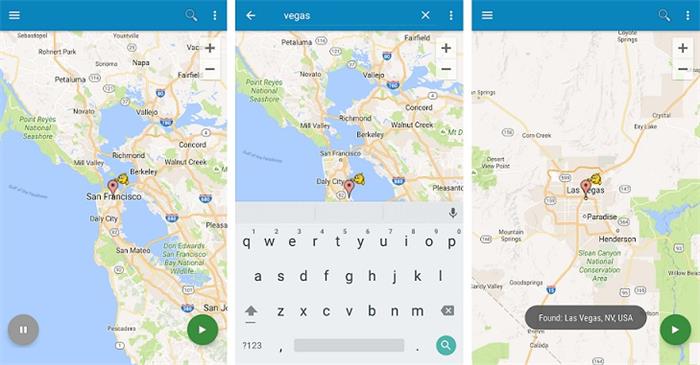
Part 1: What is Location Spoofing?
Location spoofing is a way for people to manipulate the location of GPS data shared by their devices. Faking your GPS is used for various actions, including accessing geo-blocked contents of an application, circumventing games or movies with country restrictions, or maintaining your privacy.
Using fake GPS software sends out false GPS signals from your device, hiding or changing your location. This sidesteps security as well as trust and safety terms of applications that rely on location signals.
Part 2: Ways to Fake Your GPS Location on Android and iOS
While most smartphones today have built-in methods to track your location, there are several ways to fake your GPS location, whether you’re using an iOS or Android. For whatever purpose you need to, you can download apps on the App Store or Google Play to hide your current location.
You can learn more about spoofing apps to prank your friends or play location-based games such as Pokemon Go to get more rewards.

Try to find a reliable spoofing app? The good news for you is that there is a powerful tool, Wondershare Dr.Fone – Virtual Location , which allows a one-click process to effortlessly spoof your GPS location to any destination for enhanced enjoyment in AR games.
This versatile tool effortlessly integrates with popular location-based apps such as Pokémon GO, Snapchat, Instagram, and more. Take control with the ability to simulate GPS movement along a route you draw. You can use its joystick feature to flexibly mimic GPS. It is fully compatible with the latest operating systems, supporting Android 14 and iOS 17.
Noteworthy Aspects Wondershare Dr.Fone - Virtual Location
- Wondershare Dr.Fone can maintain a record of all the routes you follow and the locations you visit to ensure you can always access them again.
- This location spoofer contains features such as a one-stop route and multi-stop route to help you mimic realistic movement when playing AR games.
- To ensure you are able to spoof your location and movement, Wondershare Dr.Fone allows you to choose between walking speed and driving speed.
Steps for Faking Your GPS Location via Wondershare Dr.Fone - Virtual Location
Spoofing your location becomes effortlessly achievable through Dr.Fone - Virtual Location. This has to do with its innovative algorithms and thanks to its user-friendly approach. The process of faking the location involves the following steps:
Step 1: Access Dr.Fone - Virtual Location and Move to Toolbox
Begin with the launch of Dr.Fone - Virtual Location on your computer and establish a connection with your Android or iOS device. Navigate to the map screen and select the “Teleport Mode” icon, which is situated as the first option in the toolbar near the top-right corner. Now, start the process by tapping the search bar at the top left corner, inputting your desired location, and hitting “Enter.”
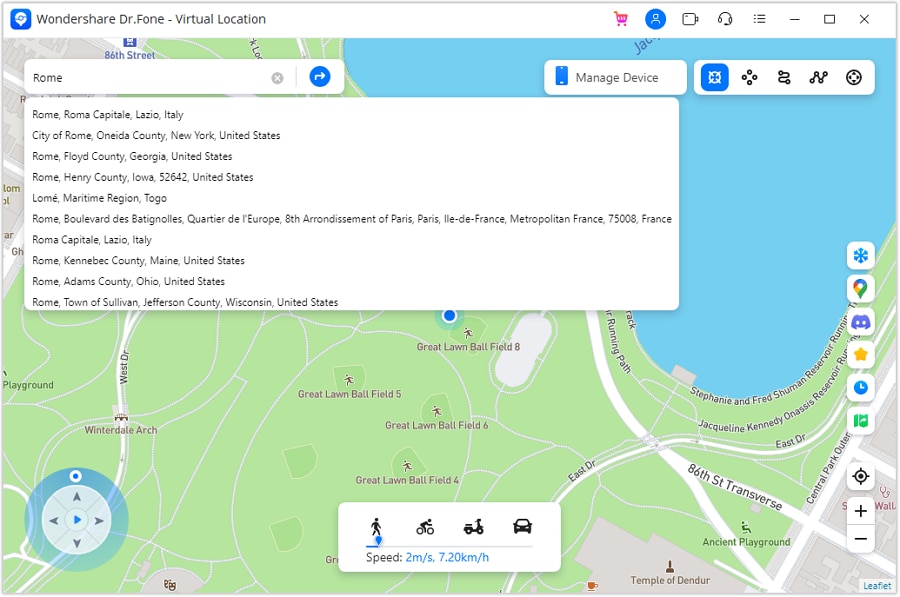
Step 2: Move to the Targeted Location and Verify It
Upon completion of the initial setup, proceed to teleport to the targeted location by clicking “Move Here” on the map screen. This action prompts the cursor to relocate to the specified location on the map. It also simultaneously adjusts the location of your Android or iOS device. To validate the successful location change, access your smartphone and open a map application.
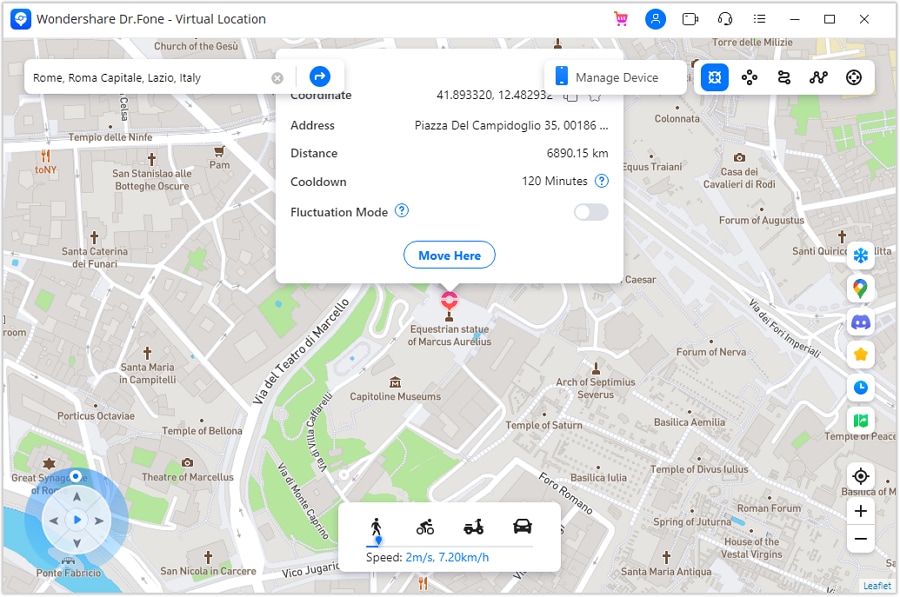
Part 3: Why is GPS Spoofing a Problem?
Faking your GPS has its advantages, primarily protecting your privacy.
However, if you’re on the receiving end of a fake GPS signal, you need to detect any spoofing attempts before it’s too late. You need to have a security measure to ensure data you’re receiving is coming from a legitimate source instead of a malicious one. It is especially important for large companies engaging in food delivery, gaming, social media, financial services, etc.
Here are some reasons why your company should be wary of GPS spoofing.
Food Delivery
Couriers who use GPS spoofing can trick food delivery apps into allowing them to accept orders they otherwise would not have access to. They may also gain an unfair advantage to gain priority in order queues and report longer rides to earn more from the platform. In addition, a more egregious issue is couriers charging for deliveries that weren’t made.

Gaming
Using GPS spoofing in MMORPGs enables gamers to take advantage of faking their position without moving into the comforts of their own home. This can lead to more in-game rewards that are otherwise difficult to achieve without GPS spoofing.
Location spoofing also allows cheaters to use hundreds of mobile devices to collude and share in-game information to scam other players.
Social Media
Having a fake GPS on dating apps allows users to unlock more users on their profile to match with in other places. It can be dangerous if scammers or fraudsters use fake GPS to trick people into concealing their actual location.
Financial Services
Most financial institutions across the globe use location data to verify users to prevent fraud. Having inaccurate data is a major security beach, especially when handling financial service apps on the internet.
There are various ways to protect yourself from being on the other end of a fake GPS location. You can easily use specialized apps, including mock location detection APKs if you’re on Android. These anti-spoofing GPS apps help detect if someone is providing fake GPS locations. However, if this is not available to you, there are several ways you can mitigate malicious actors by applying some safeguards.

Here are some of the methods you can take advantage of.
- Cross-reference location data from multiple sources to detect fake GPS locations. You can cross reference from GPS, Wi-Fi, and cell tower triangulation to analyze accurate GPS.
- Analyze abnormal patterns in location data presented to you from sudden jumps in location or having unrealistic speeds during movement.
- Verify the accuracy of GPS by comparing location data to known landmarks, including buildings, bridges, or roads.
- Using a dedicated GPS simulator and comparing results to expected from provided data.
- Have a security measure to detect GPS spoofing apps installed on a user’s smartphone.
While the methods to detect GPS locations are presented above, it’s important to remember that detecting fake GPS locations is difficult and requires you to combine different methods. You can easily detect mock locations on Android, but the methods available if you’re on a different device will vary depending on the resources at your disposal.
Conclusion
Faking your GPS is easy nowadays. You can download an application and tinker with a few settings on your smartphone to start GPS spoofing. For secure virtual navigation, make Dr.Fone - Virtual Location your first choice. As a result, anti-spoofing in GPS is are the rise, especially if you’re on the receiving end of the data.
Knowing the telltale signs of a fake GPS is a must to ensure you will not be deceived when transacting online. In the end, the most effective way to detect if someone is faking their GPS is by checking if their smartphone has a GPS spoofing app.
What is Geo-Blocking and How to Bypass it On Lava Yuva 2 Pro?
Have you ever entered a website and can’t access it because it is unavailable in your area? This is what geo-blocking means. If you want to know more about geo-blocking, you have come to the right article. This article provides the definition, symbols, function, type, and how to bypass a geo-blocked site.
Encryption is often used in geo-blocking as a means of protecting material that is restricted to users in just certain locations. In its long existence, the method has been met with several obstacles. These obstacles will be discussed in the next sections!

Part 1. What is Geo-Blocking?
This section will give you the definition of geo-blocking. It will also show how websites inform viewers that they are in geo-blocking areas.
Definition of Geo-Blocking
Geo-blocking is the practice of restricting online access to certain users depending on where in the world they happen to be physically located. Telecommunications firms, websites, and other content providers and intellectual property owners often use this method for copyright protection. To monitor and enforce geo-blocks, databases that map out IP addresses’ geographical locations are often employed.
Understanding the Main Symbols and Elements
You sometimes can’t access a site because it isn’t available in your area. This is the main element carried by geo-blocking.
Every online-surfing tool has a unique identifier called “IP address”. The address can identify the Lava Yuva 2 Pro devices’ geographical location. When users access a website, their devices send their IP addresses to the online servers. The servers read if the IP addresses are included in the allowed list and determine whether to allow the visitors to view the content.
The visitors usually know they are geographically limited through the website’s displayed outcomes, a poster indicating that the service is unavailable in the location. Take the geo-banned access by Airbnb as an example below.
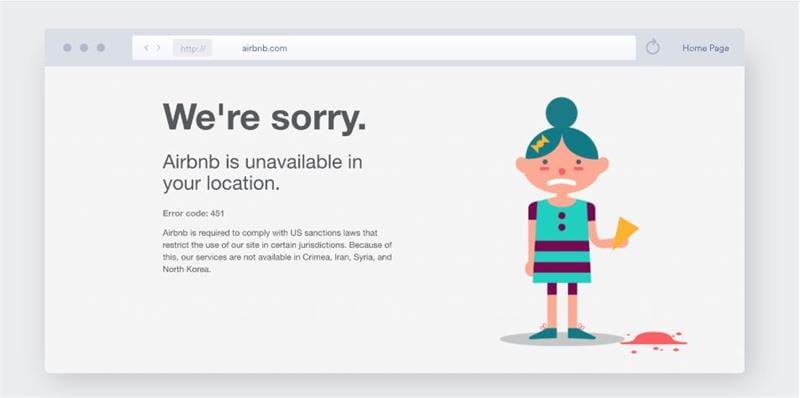
Although Airbnb has been criticized for posing a threat to the availability of low-cost lodging in metropolitan areas, it has proven to be a useful resource for travelers. However, not everyone can use it; for instance, it is unavailable in Iran due to US sanctions.
Part 2. How Does Geo-Blocking Work?
When a firm, rather than a government, is responsible for geoblocking, IP addresses are often the first line of defense. Your IP address is like a street address, revealing where you live.
IP addresses are numerical identifiers that distinguish each machine on the internet. Your computer’s IP address is sent to the server of the website you visit so that it may supply the required data.
You’ll be assigned an IP address when you sign up for an Internet Service Provider. It is possible to pinpoint the location of your device using its IP address, albeit the degree of precision may vary. Websites use the IP address to determine whether you can read their content. They will thus refuse your request if you are using an IP address that’s not on their approved list.
Part 3. Common Types of Geo-blocked Content
The difficulty stems from legal hurdles, including copyrights, licenses, and territorial disputes. Certain streaming services may not make all of their offerings accessible in all regions, or a major online shop may restrict some of their offerings to customers in just one geographic area.
Youtube
Users who upload videos can restrict access to them in certain countries. This nearly usually indicates that a business has chosen that you shouldn’t be able to see a video because of where you are located.

Spotify
You may be trying to find a method to unblock Spotify because you want to listen to unavailable music in your country or because the app has been prohibited in your area.

Live Sports
Big events may be aired exclusively by one company, which means you may be forced to pay to access certain material or go through annoying subscription hoops.

Pandora
Do you want to tune in to this online radio and music station? You can’t access it anywhere in Europe because of a regional firewall.

Porn sites
Artists from porn sites can now geo-block their movies, much like YouTube users do. Some porn sites have been outlawed in several countries, including Egypt and Pakistan, where the vast majority of the population resides.

Amazon
Amazon Prime geo-blocks other services as well as its streaming content. Games, ebooks, software, audiobooks, and other digital materials like TV and movies may be licensed and copyrighted. Amazon Prime prevents certain VPN IPs from accessing foreign content, including Netflix.

Part 4. Tips to Bypass Geo-Blocking
While certain sites may be blocked in your country, there are still methods to access the full functionality of the web. What exactly are they, and how do you go about getting them? Here’s more reading material.
Method 1. Use Smart Domain Name System (DNS)
Clever DNS can evade geoblocking if your smart TV, streaming box, or gaming console doesn’t support VPNs or proxy servers. Some home routers can generate VPN connections, but not all.
By changing your DNS address, clever DNS may alter your device’s virtual location. Smart DNS replaces your Internet provider’s DNS server. Netflix.com’s IP is not netflix.com. You’ll acquire the smart DNS provider’s transparent DNS proxy IP. Netflix thinks you’re in the US since this proxy server is.
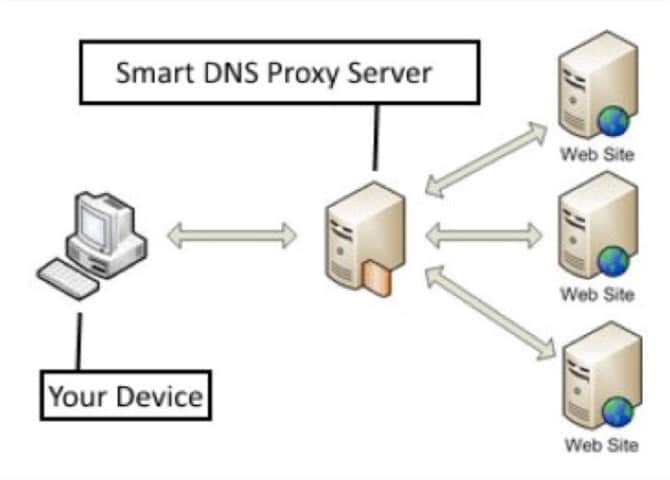
Method 2. Connect to Proxy Servers
Rather than connecting you directly to the server housing the material you want, a proxy server functions as an intermediary. A proxy server does what its name implies: it acts on your behalf to get access to the data and then forwards it to you. Proxy servers, especially those in foreign countries, may be used to get around geographical restrictions.
Depending on the kind of proxy server you use, you may or may not be able to conceal your IP address when surfing the web. Proxy servers are available online and may be accessed from any web browser. Setting up a proxy server is easy, but your activity may still be vulnerable since proxies don’t secure your data.
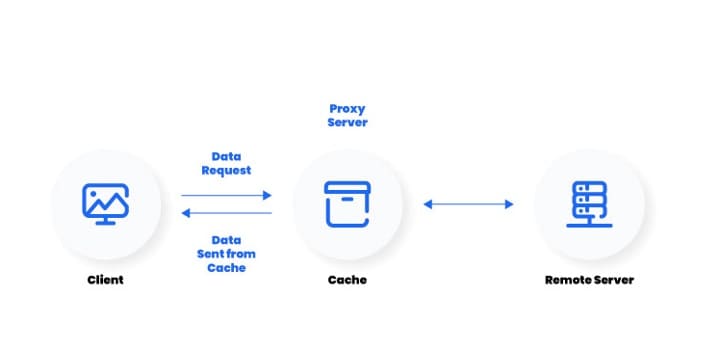
Method 3. Use the Tor Browser
In addition to using a VPN, you may use the anonymous Tor browser. The Tor browser links to the Tor network, a collection of computers that collaborate to conceal your online footprint by relaying your traffic via several intermediary nodes.
Tor employs a technique called “onion routing” to conceal its users’ identities. Since more time is required to traverse these additional levels, your internet speed may suffer as a consequence.
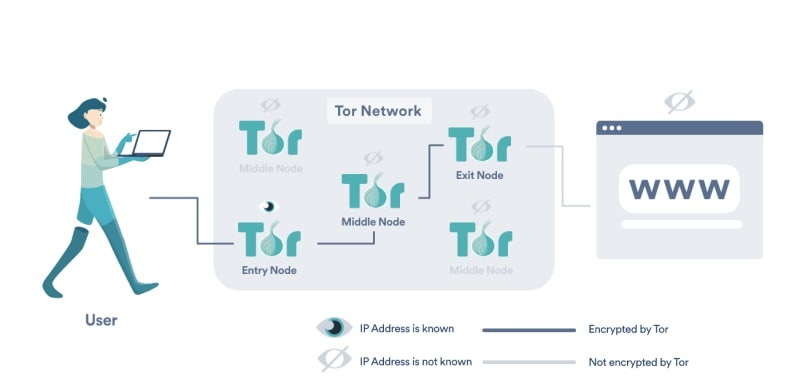
Method 4. A Good VPN Connection
A virtual private network (VPN) may hide your online identity and protect your data by encrypting your connection. VPNs allow you to get around geographically restricted material by redirecting your connection via a server in another country. This will allow you to connect to VPN servers in other countries, such as the United States, the United Kingdom, or Australia.
With effective VPN tools , you can surf the web anonymously, unblock geo-blocked content, and watch your favorite programs abroad. There are several advantages to utilizing a VPN, particularly when you travel or use public Wi-Fi, and they are simple to set up.

Part 5. FAQs About Geo-Blocking
Here are the answers to four questions that you might ask about geo-blocking.
1. Is Geo-Blocking Legal?
Yes. It’s legitimate. Limiting access to websites and services based on a user’s location is lawful. This practice is routinely used in nations like China to prevent citizens from seeing politically sensitive material. Legal arrangements, such as licensing agreements, may also be enforced by geo-blocking.
2. Is Bypassing Geo Blocking Illegal?
It depends. Depending on the situation, the nation, the purpose of the use, and the technique used, geo-blocking circumvention may be against the law. Copyright regulations prohibit users from accessing material beyond its designated location, yet many providers are reluctant to penalize users for doing so.
3. What’s the Difference Between Geo-Fencing and Geo-Blocking?
Geo-fencing is to create digital fences on which to base real-world judgments about where to go. One may draw a boundary around it using longitude and latitude lines on a map to easily establish who is permitted inside a certain region. Restricting access to material based on a user’s physical location is called “geo-blocking.”
4. Is Geo-Restricted the Same as Geo-Blocking?
They are the same. Restricting a user’s ability to access certain online resources depending on their location is known as geo-blocking or geo-restriction. To safeguard their license agreements, foreign media streaming firms often use the practice of geo-blocking.
Conclusion
For several reasons, media and content producers use geo-blocking. Although geo-blocking is unlikely to ever go out of style, there are techniques to circumvent it. Use a virtual private network (VPN) to bypass geo-restrictions on the material you want to watch. Using a Virtual Private Network (VPN), a proxy server, the Tor network, etc., your online location may be hidden or masked.
Geo-blocking controls. It’s both useful and abused. Website banning discriminates and manipulates. Geography may be annoying and frustrating. Sadly, they may always be in style. You don’t have to tolerate them!
Prank Your Friends! Easy Ways to Fake and Share Google Maps Location On Lava Yuva 2 Pro
Google Maps is a virtual map for mobile and PC use. With it, you can check routes and street maps with unreal aerial imagery. However, sometimes you might want to fake Google Maps location. Google maps location. For example, you might want to tag your friends or followers with a new fake location. Or, you might want to prevent apps like Google Chrome from accessing your actual location. Whichever the case, this article teaches you how to fake GPS on Google maps without breaking a sweat. Let’s learn!
Part 1: How to Fake or Spoof Your Location in Google Maps?
You may think I should be turning off the location setting and wifi services to show fake locations on google maps. Well, I tried this, but it did not work, unfortunately. Google Maps can still track me. This is because Google Maps can use the signal strength of cell towers around me to guess my location, and believe me, this guess is usually very accurate. Also, the IP of the phone can be used. Here, we provide two effective methods for you to fake and change location in Google Maps at ease.
Method 1: Spoof location in Google Maps with a tool for both iOS and Android
If you want to fake Google maps location on iPhone, then you’ll have to put more effort than an Android device. Just installing an app might not work out to spoof Google Maps location on an iPhone. Nowadays, region-based games and apps are boring, and people need more options to explore. It is possible to share fake Google map locations by using different regions through a few clicks. Dr.Fone - Virtual Location has much more innovative ways to do that.
You need to download this app to use its incredible features. It’s a 1- click location-changing software that can outdo any other software in the market. This is the safest way to change Android and iPhone Locations without Jailbreak. Also, you get to enjoy other useful features of this software such as Phone Transfer, WhatsApp Transfer with the location changing.
Features:
- Allows users to simulate GPS movement along a route as they draw.
- One-click teleportation of GPS location to anywhere system available.
- There is a joystick available to spoof GPS movement comfortably.
- You can use this software with various location-based apps, like Pokemon Go, Snapchat, Instagram, etc.
- It’s compatible with both iOS and Android operating systems.
Here is a video tutorial for you to have a quick view on Google maps location changing.

Step-by-step Guide to Fake Google Maps Location with Dr. Fone Virtual Location:
Step 1: First, you need to download, install and launch the Dr. Fone Virtual Location software on your computer. From the software’s home page, you need to select the “Virtual Location” option from a bunch of other options.

Step 2: Next, you need to connect your Lava Yuva 2 Pro to the computer by using a cable.
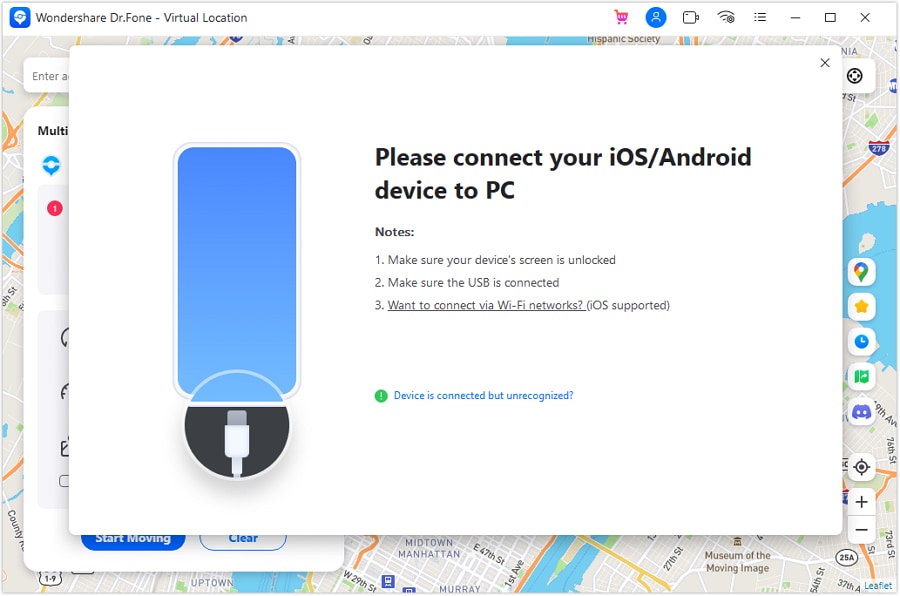
Step 3: On the next window, you’ll find the world map on your screen, and the coordinates and directions are clear on the map. You need to click on the third icon called the “Teleport Mode” from the top right corner of your screen. Then type in the place’s name in the search box where you want to change your location. There is also a way to pinpoint the area if you know it properly.

Step 4: After becoming sure of your new location, click on the “Move Here” button to change your location from the real one to the virtual one you selected.

Method 2: Change location in Google Maps with a VPN
An array of VPN apps come with built-in location spoofing features on top of the usual IP address masking. For example,
1. Nord VPN
NordVPN includes additional features to stay ahead of Hulu’s VPN blocks. It has a Smart DNS tool, to unblock streaming apps on games consoles and Smart TVs, and a functional app for Amazon Fire TV, too, though, it isn’t quite as fast as ExpressVPN, but it’s more than fast enough for HD streaming.
Pros
- Affordable price tag
- Useful Smart DNS feature
- IP and DNS leak protection
Cons
- Speed Slower than ExpressVPN
- Only one Japan server location
- Unable to pay by PayPal
2. ExpressVPN
ExpressVPN can bypasses many streaming blocks, like Hulu’s, and it delivers a fast long-distance speeds connecting to America from overseas compared to other vpns. Also, it provides many Japanese server locations, including the main big cities in Japan, Tokyo and Osaka.
Pros
- Fast speed
- In-built DNS and IPv6 leak protection
- Smart DNS tool
- 14 US cities and 3 Janpanese location severs
Cons
- More expensive than other VPN providers
3. Surfshark
Surfshark is relatively new to the market and only emerged some time back in 2018. It’s available now at a great price compared to current top dogs in the market.
Pros
- Affordable price tag
- Safe & private connection
- Smooth user experience
Cons
- Weak social media connection
- New to industry, unstable for sometime
VPNs change your perceived location by swapping out your real IP address with that of the VPN server. IP addresses are unique sequences of numbers and decimals that identify every device on the internet. An IP address can be used to approximate a device’s location.
Step-by-step guide for faking location in Google Maps with a VPN
No matter what VPNs you are using, the steps are basically as same as the following:
- Open a VPN app on your phone.
- Choose a country IP address that you hope to change to.
- Switch the button to make a connection on VPN.
- Refresh or reopen your Google Map, and then input your desired location on its search section.
- It’s complished when the desired location is found.
Part 2: How to Share Your Location in Google Maps?
For iPhone users, you can share your Google map location through the following steps:
- Start Google Maps on your Lava Yuva 2 Pro.

- Click on your profile avatar, and in the menu, click Location sharing. If you are already sharing your location, you will tap New share.
![]()
- Now select the contact you want to share your location with and also how long you will share.

- Click Share.
Or you can directly mark a location you wanna go to first, and tap the “Share” button, then choose the channels you want to share. You can share through WhatsApp, Telegram, Instagram, etc.

Also, follow the steps below if you are using an Android phone:
- On your Lava Yuva 2 Pro or tablet, open the Google Maps app Google Maps.
- Search for a place. Or, find a place on the map, then touch and hold to drop a pin.
- At the bottom, tap the place’s name or address.
- Tap the Share icon. If you don’t see this icon, tap More and then Share.
- Choose the app where you want to share the link to the map.
Part 3: FAQ: All You Wanna Know about Location Changing on Your Lava Yuva 2 Pro
1. How can I add my favorite route as favorite?
In the reallocation screen, you’ll be able to find the five-star icon on the proper sidebar and, therefore, the new window after you use the three provided modes. A simple click to feature the route to your favorites. After you boost features, it’ll show you “collection successfully,” and also the five stars icon will display a red icon, and you’ll also enter to test what percentage you have ever strengthened.
2. How to turn off your location on an iPhone device?
You can do that by changing the settings on your device. Settings >> privacy options>> location services, then turn the icon to the left, which will indicate that your location is off.
3. How to turn off your history on an iPhone device?
To turn off the History, stick to the same icon of settings, and from the system services, check your significant locations, and you can delete them as well.
4. How does one give someone your location from your Lava Yuva 2 Pro?
Start with opening the “Find My” app on your Lava Yuva 2 Pro and choose the “People” tab. Select share my location and enter the name or number of the person you wish to share your location with. In the end, tap send and share your site with someone you want to share.
Final Words
We’ve discussed the fake Google maps location through different methods in this detailed guide. Android and iOS users can use various apps to fake their location. For iOS users, Dr.Fone - Virtual Location is a perfect choice to spoof Google maps location without doing much work. Sharing fake locations in Google maps is a straightforward thing to do. Whether you want to use it to prank your friends, otherwise, you may have a more serious reason. By following the above steps outlined in this article, you will convince Google that you are anywhere within the world.
Also read:
- [Updated] 2024 Approved Mastering the Art of IGTV A Comprehensive Guide for Social Media Pros
- [Updated] Hilarity in HD The Best Photo Editing Tools Online
- 2024 Approved Demystifying Payment Systems in Shortform Creator Ecosystem
- 2024 Approved Efficiently Start & Schedule a Zoom Call on Any Android Device
- Decoding ESD Files and Their Conversion Into ISO on Windows OS
- Does Life360 Notify When You Log Out On Nokia C02? | Dr.fone
- Dose Life360 Notify Me When Someone Checks My Location On Apple iPhone 6s? | Dr.fone
- Fake the Location to Get Around the MLB Blackouts on Apple iPhone 13 mini | Dr.fone
- Full Guide to Fix iToolab AnyGO Not Working On Apple iPhone X | Dr.fone
- How to Fix OnePlus Nord N30 5G Find My Friends No Location Found? | Dr.fone
- How to Use Life360 on Windows PC For HTC U23 Pro? | Dr.fone
- Navigating TV Shopping: A Beginner's Guide to Upgrading Your Home Viewing Experience
- New In 2024, Explore the Advanced Tools to Help You Reshape the Art of Sky Replacement in Digital Imagery. Discover Methods to Enhance Your Visual Narratives Through AI
- Symbolizing Success Affordable & Flexible Logo Crafting From Templates for 2024
- Thinking About Changing Your Netflix Region Without a VPN On Vivo V27e? | Dr.fone
- Top Tracks of the Decade on Spotify for 2024
- What is Geo-Blocking and How to Bypass it On OnePlus Open? | Dr.fone
- What is Geo-Blocking and How to Bypass it On Realme 11 Pro+? | Dr.fone
- What is Geo-Blocking and How to Bypass it On Sony Xperia 1 V? | Dr.fone
- Title: Apply These Techniques to Improve How to Detect Fake GPS Location On Lava Yuva 2 Pro | Dr.fone
- Author: Ava
- Created at : 2025-02-03 17:32:28
- Updated at : 2025-02-08 18:12:10
- Link: https://fake-location.techidaily.com/apply-these-techniques-to-improve-how-to-detect-fake-gps-location-on-lava-yuva-2-pro-drfone-by-drfone-virtual-android/
- License: This work is licensed under CC BY-NC-SA 4.0.